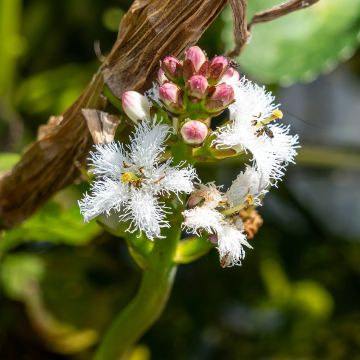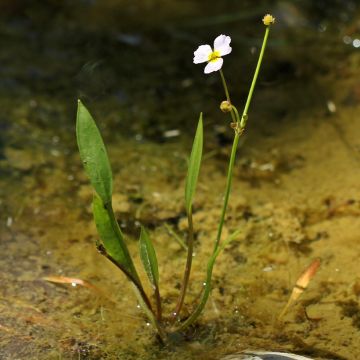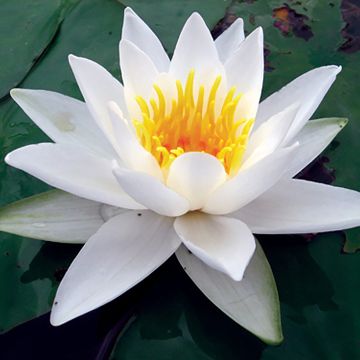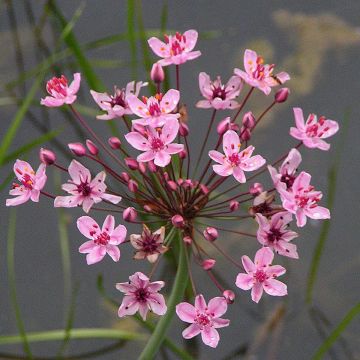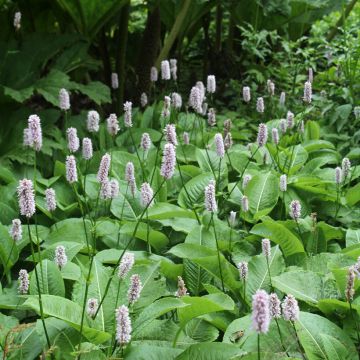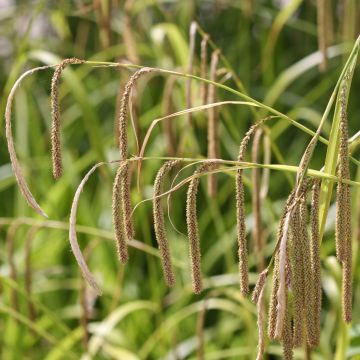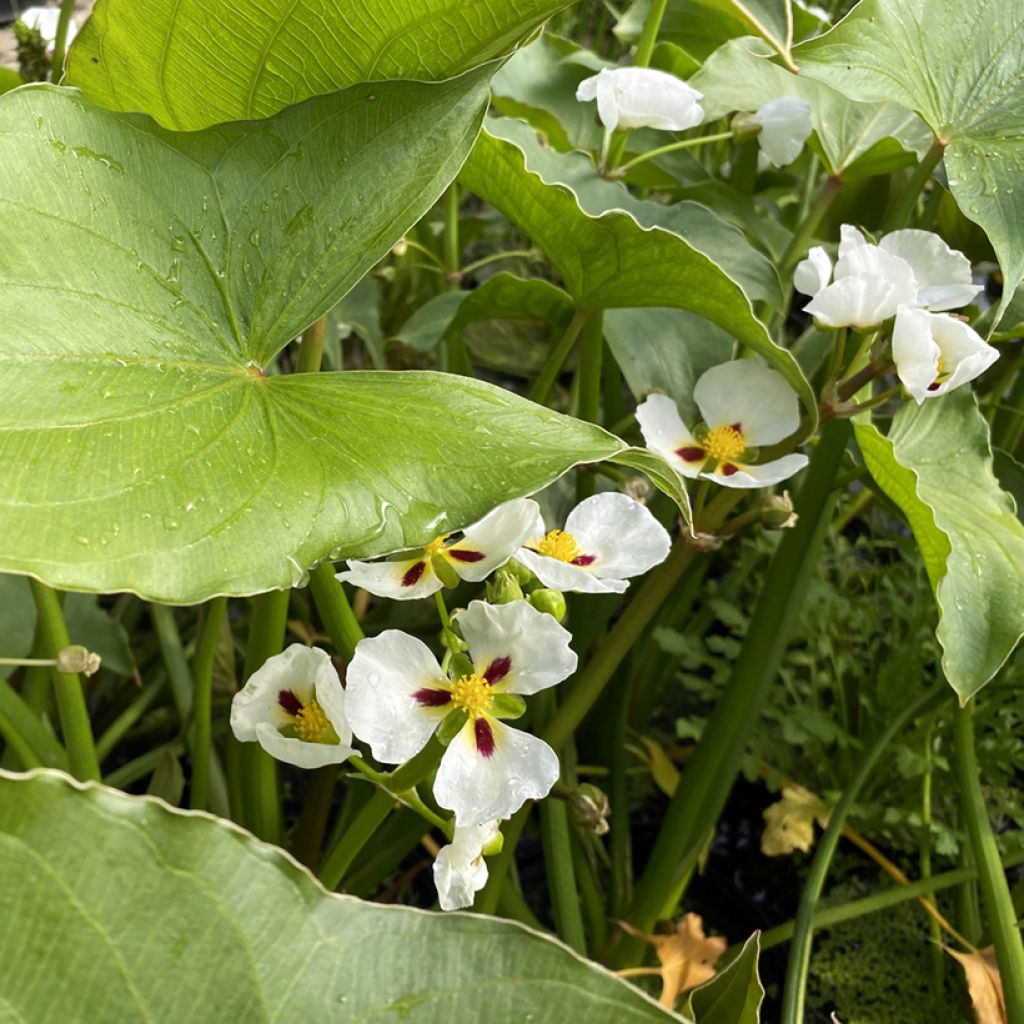

Sagittaria montevidensis - Giant Arrowhead
Sagittaria montevidensis - Giant Arrowhead
Sagittaria montevidensis
Giant Arrowhead, California Arrowhead
Why not try an alternative variety in stock?
View all →This plant carries a 12 months recovery warranty
More information
We guarantee the quality of our plants for a full growing cycle, and will replace at our expense any plant that fails to recover under normal climatic and planting conditions.
From €5.90 for pickup delivery and €6.90 for home delivery
Express home delivery from €8.90.
Does this plant fit my garden?
Set up your Plantfit profile →
Description
The Sagittaria montevidensis, also known as Montevideo Arrowhead, is a perennial aquatic plant that thrives in shallow areas of aquatic environments, particularly at a water depth between 5 and 20 cm. Its arrow-shaped leaves, characteristic of its botanical genus, distinguish it by its exceptional flowers. Its magnificent white flowering adorned with a purple-red heart, which extends from late spring to late summer, brings a touch of purity and elegance to the water's surface. It effortlessly enlivens aquatic scenes with lush foliage and large, wind-blown stems.
The Sagittaria montevidensis, more commonly known as Montevideo Arrowhead or Argentine Water Arrowhead, belongs to the family Alismataceae. This family encompasses herbaceous plants, mostly perennial and rhizomatous, adapted to aquatic environments in temperate, subtropical, or tropical regions. Native to South America, the Sagittaria montevidensis is found in Argentina, Bolivia, Chile, Ecuador, Brazil, Mexico, Peru, and, of course, Uruguay, particularly in the province of Montevideo, where it grows along the many small coastal rivers in the region. It thrives along watercourses, in mudflats, as well as on riverbanks and lake shores.
This herbaceous perennial plant, with underground rhizomes, forms a clump reaching a height of 0.50 to 0.90 m and consists of deciduous foliage arranged in a rosette. Submerged leaves are ribbon-like, while emergent leaves are shaped like arrowheads and smooth, measuring 20 to 30 cm long and up to 23 cm wide, rising on a long cylindrical and spongy petiole that can reach 75 cm long. Flowering occurs from June to September, and the flowers emerge from the vegetation on floral stems shorter than the leaves and trailing. The flowers, arranged in whorls or pairs at the nodes, have a 2 to 3 cm diameter. They contain three white petals marked with a wine-coloured spot and three green sepals. Each flower bears 12 stamens with yellow anthers. Pollination is carried out by insects, leading to the formation of a small capsule containing the seeds. These seeds are dispersed by water or attached to animals' hair, legs, or feathers. The seeds easily spread in mild climates.
The Montevideo Arrowhead, modest in appearance, offers particularly charming small flowers. Although it is affected by frost every winter, it regrows late from the stump in hotter climates. Therefore, in mild climates, it can be planted in open ground, but in cooler climates, pot cultivation is preferable. It thrives ideally in ponds and artificial pools submerged in water with a depth ranging from 5 to 20 cm. It thrives in full sun or slightly shaded areas in various soil types, whether acidic, slightly alkaline, or neutral, as long as they are rich in humus. For a balanced composition, combine Sagittaria montevidensis with plants suitable for riverbanks and shallow areas, such as Juncus inflexus, Asclepias incarnata, Lobelia cardinalis, Iris versicolor, Iris pseudacorus, Cyperus papyrus Cleopatra, Thalia dealbata (Water Canna), Iris pseudacorus Crème de la Crème (Yellow Flag Iris), and wetland grasses like Carex pendula, Cotton Grass (Eriophorum angustifolium), or Milium effusum ‘Aureum’.
To control the plant's seed propagation, it is advisable to prune the inflorescences once they have dried.
Report an error about the product description
Flowering
Foliage
Plant habit
Botanical data
Sagittaria
montevidensis
Alismataceae
Giant Arrowhead, California Arrowhead
South America
Other Aquatic perennials
Planting and care
Plant the Montevideo Arrowhead in various environments, such as stagnant or slightly flowing water, marshy areas, shallow parts of basins, and small, medium, and large ponds. In mild climates, it can be planted directly in the ground, but in cool climates, pot or basket cultivation is preferable.
Plant it in a submerged area between 5 and 20 cm of water height, in rich soil, even clayey or loamy-clayey, slightly acidic to neutral. Planting can be done all year round, except during freezing periods, but it is ideal to plant it from March to May to establish itself before the winter cold. Please place it in a well-sunlit or slightly shaded location. It is a plant of marshy areas that require constant moisture at the root level, ensuring that it does not exceed a permanent immersion of more than 30 cm of water. It prefers to have at least 10 to 25 cm of water above the base, protecting it from winter cold.
Dig a planting hole in the mud in a pond, basin, or on the banks of a large body of water and plant your Sagittaria montevidensis, ensuring the top of the root ball is at ground level. For a better effect, plant in groups of 5 to 7 specimens, with the average planting distance between plants being about 40 to 50 centimetres.
Planting period
Intended location
Care
This item has not been reviewed yet - be the first to leave a review about it.
Aquatic plants
Haven't found what you were looking for?
Hardiness is the lowest winter temperature a plant can endure without suffering serious damage or even dying. However, hardiness is affected by location (a sheltered area, such as a patio), protection (winter cover) and soil type (hardiness is improved by well-drained soil).

Photo Sharing Terms & Conditions
In order to encourage gardeners to interact and share their experiences, Promesse de fleurs offers various media enabling content to be uploaded onto its Site - in particular via the ‘Photo sharing’ module.
The User agrees to refrain from:
- Posting any content that is illegal, prejudicial, insulting, racist, inciteful to hatred, revisionist, contrary to public decency, that infringes on privacy or on the privacy rights of third parties, in particular the publicity rights of persons and goods, intellectual property rights, or the right to privacy.
- Submitting content on behalf of a third party;
- Impersonate the identity of a third party and/or publish any personal information about a third party;
In general, the User undertakes to refrain from any unethical behaviour.
All Content (in particular text, comments, files, images, photos, videos, creative works, etc.), which may be subject to property or intellectual property rights, image or other private rights, shall remain the property of the User, subject to the limited rights granted by the terms of the licence granted by Promesse de fleurs as stated below. Users are at liberty to publish or not to publish such Content on the Site, notably via the ‘Photo Sharing’ facility, and accept that this Content shall be made public and freely accessible, notably on the Internet.
Users further acknowledge, undertake to have ,and guarantee that they hold all necessary rights and permissions to publish such material on the Site, in particular with regard to the legislation in force pertaining to any privacy, property, intellectual property, image, or contractual rights, or rights of any other nature. By publishing such Content on the Site, Users acknowledge accepting full liability as publishers of the Content within the meaning of the law, and grant Promesse de fleurs, free of charge, an inclusive, worldwide licence for the said Content for the entire duration of its publication, including all reproduction, representation, up/downloading, displaying, performing, transmission, and storage rights.
Users also grant permission for their name to be linked to the Content and accept that this link may not always be made available.
By engaging in posting material, Users consent to their Content becoming automatically accessible on the Internet, in particular on other sites and/or blogs and/or web pages of the Promesse de fleurs site, including in particular social pages and the Promesse de fleurs catalogue.
Users may secure the removal of entrusted content free of charge by issuing a simple request via our contact form.
The flowering period indicated on our website applies to countries and regions located in USDA zone 8 (France, the United Kingdom, Ireland, the Netherlands, etc.)
It will vary according to where you live:
- In zones 9 to 10 (Italy, Spain, Greece, etc.), flowering will occur about 2 to 4 weeks earlier.
- In zones 6 to 7 (Germany, Poland, Slovenia, and lower mountainous regions), flowering will be delayed by 2 to 3 weeks.
- In zone 5 (Central Europe, Scandinavia), blooming will be delayed by 3 to 5 weeks.
In temperate climates, pruning of spring-flowering shrubs (forsythia, spireas, etc.) should be done just after flowering.
Pruning of summer-flowering shrubs (Indian Lilac, Perovskia, etc.) can be done in winter or spring.
In cold regions as well as with frost-sensitive plants, avoid pruning too early when severe frosts may still occur.
The planting period indicated on our website applies to countries and regions located in USDA zone 8 (France, United Kingdom, Ireland, Netherlands).
It will vary according to where you live:
- In Mediterranean zones (Marseille, Madrid, Milan, etc.), autumn and winter are the best planting periods.
- In continental zones (Strasbourg, Munich, Vienna, etc.), delay planting by 2 to 3 weeks in spring and bring it forward by 2 to 4 weeks in autumn.
- In mountainous regions (the Alps, Pyrenees, Carpathians, etc.), it is best to plant in late spring (May-June) or late summer (August-September).
The harvesting period indicated on our website applies to countries and regions in USDA zone 8 (France, England, Ireland, the Netherlands).
In colder areas (Scandinavia, Poland, Austria...) fruit and vegetable harvests are likely to be delayed by 3-4 weeks.
In warmer areas (Italy, Spain, Greece, etc.), harvesting will probably take place earlier, depending on weather conditions.
The sowing periods indicated on our website apply to countries and regions within USDA Zone 8 (France, UK, Ireland, Netherlands).
In colder areas (Scandinavia, Poland, Austria...), delay any outdoor sowing by 3-4 weeks, or sow under glass.
In warmer climes (Italy, Spain, Greece, etc.), bring outdoor sowing forward by a few weeks.

































